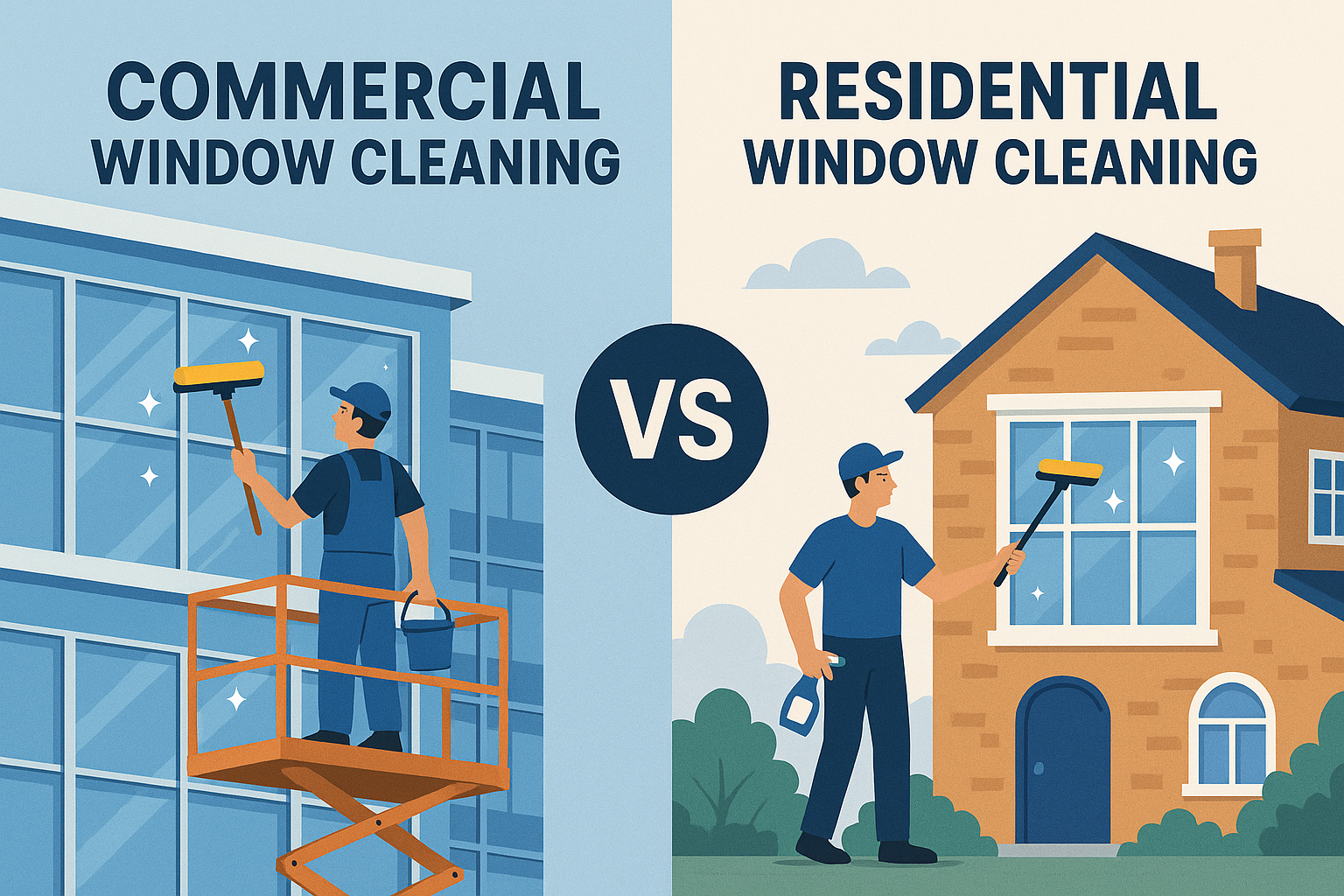Exterior Cleaning Services: What Homeowners Should Expect
Booking an exterior clean can feel like letting a pit crew take over your home for a day. Hoses snake along pathways, pumps hum, and patios gleam again. If it’s your first time, a clear picture of what actually happens can put you at ease and help you get better results from the visit.
What to sort out before the van arrives
You don’t need to roll out a red carpet, but a bit of preparation makes the visit smoother and helps the team get straight to work.
- Parking: reserve space on your drive or outside your home. Many teams carry large tanks and machinery that are easier to manage close to the property.
- Access: unlock side gates, move vehicles off the drive, and clear the route to outdoor taps and sockets.
- Water and power: most services bring water, yet many still connect to an outside tap for top‑ups. If power is required, they will advise you.
- Windows and doors: shut everything and let the team know about any trickle vents that should stay closed.
- Pets and children: keep them indoors or away from work zones. Surfaces can be slippery during and after cleaning.
- Fragile items: move planters, furniture, toys, doormats, and ornaments from the cleaning area.
- Neighbours: a quick heads‑up if work will be close to a boundary, especially where overspray might cross a fence line.
- Pre-existing issues: if you’re aware of loose pointing, flaking paint, or cracked slabs, tell the crew before they start. Photos taken beforehand help with clarity on both sides.
A short call the day before is common, especially if weather might affect timing. Many firms keep flexible slots to avoid heavy rain or high winds.
The first ten minutes: survey and plan
Expect a friendly walk‑round and a few targeted questions. A professional will look for:
- Surface materials: brick, natural stone, concrete, tarmac, render, timber cladding, uPVC.
- Condition: friable mortar, oxidised cladding, hairline cracks, algae type and density, efflorescence, rust stains, oil patches.
- Drainage: where the water will run, location of drains, soakaways, lawns and flowerbeds.
- Sensitive areas: electrical outlets, air source heat pumps, door thresholds, recently painted sections, leadwork.
You should see a quick risk assessment, often written, especially for larger jobs. In the UK this may come bundled with a method statement. It isn’t paperwork theatre. It tells you how they’ll stay safe and protect your property.
A good operator will then confirm scope and order of work. This is the moment to refine: driveway only or driveway and pathways, inside of gutters or just the outsides, render cleaning on the rear elevation but not the loft dormer. Clear scope avoids surprises.
Patch tests are common on delicate surfaces. They’ll wet an inconspicuous area, try a cleaning setting or treatment, and show you the outcome.
Tools you’re likely to see
Exterior cleaning is not a one‑setting pressure washer and a prayer. The kit is varied and often tailored to each part of your property.
- Pressure washer with adjustable pressure and flow, along with specific nozzles for different surfaces.
- Rotary surface cleaner for large flat areas like driveways and patios, which gives an even finish and speeds up work.
- Low‑pressure application systems for gentle washing of render and cladding, often with biocidal treatments to tackle organic growth.
- Pure water poles for windows and frames, using deionised water that dries clear without spotting.
- Gutter vacuum systems with cameras to show before and after images from ground level.
- Steam cleaning units for delicate stonework, where heat rather than force does most of the work.
- Ladders, scaffold towers, or MEWPs where safe access is needed, along with harnesses and stabilisers.
- PPE: gloves, goggles, boots, hearing protection, and often hi‑vis gear if working near a road.
- Protection and control items: tarps, sheeting, plant guards, silt socks for drains, and neutralising agents for certain chemicals.
Step‑by‑step on the day
The workflow changes depending on the property, yet certain steps are consistent.
- Setup and protection
- The team places cones or signs, especially if they are near public paths or roads.
- Hoses are run neatly to avoid trip hazards.
- Electrical items and vents are covered or avoided.
- Plants near treated areas are pre‑wetted to reduce the chance of leaf scorch if a chemical treatment is used.
- Drains may be fitted with filters to catch silt.
- Pre‑treatments
- Oily spots on a driveway might receive a degreaser and agitation with a stiff brush.
- Algae on render often gets a biocide application to break down growth before rinsing.
- Rust staining from metal furniture or drips may require a specialist remover. These can be extra, because they are slower and the chemicals are pricier.
- Cleaning passes
- Flat surfaces: a rotary cleaner covers the bulk area, then the wand is used to do edges and corners.
- Vertical surfaces: a gentle wash is applied bottom to top to avoid streaking, then rinsed top to bottom.
- Windows: poles with soft brushes wipe frames and glass with pure water, followed by a rinse.
- Gutters: the vacuum clears debris, and a camera shows the cleared channels.
- Rinse down and tidy
- A thorough rinse pulls residues from cracks and edges so marks don’t reappear when dry.
- Sanding of block paving may happen the same day if the surface is dry, or on a follow‑up visit in damp weather.
- Any protective covers come off, and the area is left neat.
- Review
- You’ll be invited to walk round. On render or roof treatments, the operator will explain what will improve over the next few days and what is already at its best.
- Photos or short video clips are common now, especially for hard‑to‑see areas like chimney stacks or gutters.
Safety to expect from a reputable team
Professional exterior cleaning should look safe and feel safe. You should notice:
- PPE worn consistently, not just when you’re watching.
- Stable ladders, footers, or a tower for work at height. No balancing on sills.
- Clear barriers or cones if hoses cross public paths.
- Respect for electrics. Outdoor sockets covered or avoided. No spraying into vents.
- Chemical containers labelled properly with safety data to hand. Plants wetted before and after treatment where needed.
- Stop‑work calls when wind is fierce, storms roll in, or temperatures are near freezing.
Slip risk is real. Freshly cleaned paths and decks can be slick until fully dry, especially in cold or shaded areas. Look for warning signs placed where people might step.
How long it all takes
Timeframes vary with property size, surface type, soil level, and the weather on the day, yet these guides help set expectations:
- Gutter clearing on a typical semi: 1 to 2 hours.
- Fascia, soffit, and exterior plastics clean: 1 to 3 hours.
- Driveway around 40 square metres: 2 to 3 hours for cleaning, plus time for re‑sanding if required.
- Full house wash with render soft wash and window clean: 3 to 6 hours.
- Roof moss removal on a three‑bed house: 1 to 2 days, with biocide applied after scraping.
- Delicate stone steam clean on a facade: half a day to a full day depending on size.
Treatments like biocides can keep working after the team leaves. You might see further brightening across the next few days or weeks, particularly on north‑facing walls.
What you can do while they work
- Keep doors and windows closed until the team says it’s fine to open them.
- Keep children and pets away from work zones and wet surfaces.
- Avoid driving on a freshly cleaned and re‑sanded driveway until advised.
- Ask questions and request mid‑job updates, but give the team space to focus and stay safe.
Tea is optional. A quick check‑in partway through is more useful.
How to judge the finish
A clean property should look consistently fresh without damage or odd patterns. Use this quick scorecard:
- Evenness: no zebra stripes on patios, no missed patches behind bins or planters, no pale halos around heavy items that were moved during the clean.
- Edges and corners: crisp finish right up to the thresholds and around drain covers.
- Render and cladding: algae gone, no scarring, no blown paint, and no chalky trails down the wall.
- Driveways: a uniform tone. On block paving, new kiln‑dried sand brushed into joints where needed.
- Windows: clear glass with minimal spotting once dry. If a render treatment was done, a quick return rinse might be scheduled the next day.
- Gutters: camera proof of cleared channels and downpipes that run freely during a test pour.
- Roofs: moss removed neatly with tools designed for the tile profile. Staining will fade with the biocide rather than disappearing instantly.
Some marks have deeper roots. Oil that has soaked deep into concrete, orange rust, and black lichen spots can require repeat treatments or may never vanish completely without risking the surface. A trusted operator will set that expectation before they start.
Aftercare that extends the clean
Simple habits keep the fresh look for longer.
- Rinse down high‑traffic paths occasionally with a garden hose to remove dirt before it beds in.
- Keep leaves and soil off patios. Organic debris feeds algae.
- Trim back dense foliage that shades walls and holds moisture.
- Re‑sand block paving joints after heavy rain if sand has washed out.
- Consider a sealer for some surfaces, but take advice. Sealers vary, can change colour, and some make surfaces slippery when wet. Always ask for a test patch.
- Schedule periodic treatments: gutter clearing once a year, biocide wash on render every 1 to 3 years, roof treatment every 2 to 3 years depending on shade and tree cover.
If a chemical treatment was used, you might smell a faint whiff for a short time. A good rinse of nearby planting after the job helps protect foliage. Any smell should dissipate quickly.
Pricing, scope, and what is usually included
Quotes for commercial and residential properties can be fixed for a clear scope or based on measured areas. Ask for a breakdown that lists:
- Areas covered and the order of work.
- Pre‑treatments, cleaning passes, and rinsing.
- Re‑sanding of block paving if included.
- Waste management where applicable.
- Return visits (for example, a follow‑up rinse or sand top‑up if weather prevented it on the day).
- Optional extras like stain removal, sealer application, or window cleaning after a wall wash.
Payment methods often include bank transfer, card, or invoice on completion. Larger projects might have a deposit and staged payments.
Insurance matters. Public liability cover and, where relevant, evidence of training for working at height are standard. Guarantees for treatments vary. A biocide on render usually comes with a time‑based expectation rather than a hard warranty, because regrowth is influenced by shade, weather, and nearby vegetation.
Red flags and green flags when choosing a provider
A bit of vetting pays off.
Green flags:
- Clear written quote and scope, not a vague day rate with no detail.
- Before and after photos of similar properties.
- Branded vehicle and tidy kit.
- Willingness to patch test and adjust method for your surfaces.
- References or reviews that mention communication and care, not just speed.
Red flags:
- Insisting on blasting high pressure at painted render or soft stone.
- No interest in pre‑wetting plants or protecting drains during chemical treatments.
- No insurance, no paperwork, cash only, or pressure to decide on the spot.
- Refusal to show chemical labels or safety data.
- Dismissive of your concerns about pointing, seals, or previous damage.
A short set of questions can help you decide: What method will you use on each surface? How will you protect plants and drains? What happens if it rains? If something marks or goes wrong, how do you put it right?
Weather and timing through the year
Exterior cleaning runs year‑round, yet season shapes the plan for both residential and commercial properties.
- Spring: popular for patios and driveways before outdoor living kicks off.
- Summer: early starts help avoid hot midday sun that can dry detergents too fast.
- Autumn: gutter clearing spikes once leaves fall.
- Winter: algae treatment is very effective, but freezing surfaces can be unsafe, and many firms limit work during frosts.
If your booking depends on dry weather for re‑sanding or sealing, expect the schedule to flex a little.
A quick homeowner checklist
Before the visit:
- Confirm parking and access.
- Clear the work area and move fragile items.
- Close windows and doors.
- Point out any damage or sensitive spots.
- Arrange pets and children to stay clear.
During the visit:
- Keep access routes free.
- Ask for progress updates.
- Stay off wet surfaces.
After the visit:
- Walk round with the operator.
- Keep vehicles off newly cleaned and re‑sanded driveways until advised.
- Rinse plants later in the day if a treatment was used.
- Note any areas to revisit and agree a plan.
Small details that make a big difference
- Drain care: silt socks and filters stop debris moving into the system. If a heavy clean is planned, a quick chat about where water should go avoids puddles on neighbours’ land.
- Noise: machines are usually no louder than a lawn mower. If you work from home, consider headphones or a quiet room away from the drive.
- Access height: dormers and three‑storey sections can be cleaned from the ground with poles in many cases, but some tasks still need lift access. Planning this ahead saves time and cost.
- Windows after wall cleaning: a post‑wash window rinse keeps glass spotless and is often included on modern packages.
- Heritage surfaces: steam or ultra‑low pressure with specialist nozzles often wins. Patience beats power on old stone and lime mortar.
A well‑run exterior clean feels organised, careful, and effective. With clear expectations and a bit of preparation, you end the day with crisp paths, brighter walls, free‑flowing gutters, and the confident sense that your home is cared for properly.







